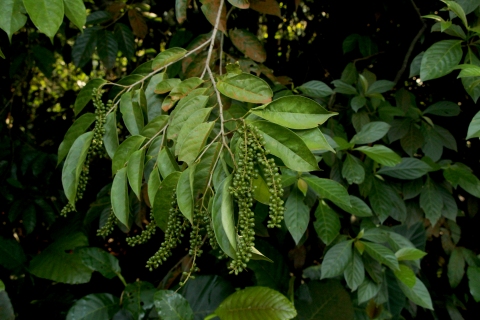Antidesma cuspidatum
Müll.Arg.
Phyllanthaceae
Antidesma rotatum Müll.Arg.
Common Name:

Fruiting branches
Photograph by: loupok


Fruiting branches
Photograph by: loupok


Flowering branch
Photograph by: loupok

General Information
Antidesma cuspidatum is sometimes a shrub but more commonly a tree that can grow up to 17 metres tall. The bole can be up to 20cm in diameter; it can be straight, branched or crooked, sometimes fluted[
327- Title
- Euphorbiaceae of Malesia
- Publication
-
- Author
-
- Website
- http://www.nationaalherbarium.nl/euphorbs/
- Publisher
-
- Year
- 0
- ISBN
-
- Description
- An online resource that is still being developed, it gives detailed botanical descriptions of plants in the family Euphorbiaceae found growing in Malesia (the region from Peninsual Malaysia through Indonesia, the Philippines).
].
The tree is sometimes harvested from the wild for local use of its wood.
Known Hazards
None known
Botanical References
327- Title
- Euphorbiaceae of Malesia
- Publication
-
- Author
-
- Website
- http://www.nationaalherbarium.nl/euphorbs/
- Publisher
-
- Year
- 0
- ISBN
-
- Description
- An online resource that is still being developed, it gives detailed botanical descriptions of plants in the family Euphorbiaceae found growing in Malesia (the region from Peninsual Malaysia through Indonesia, the Philippines).
Range
Southeast Asia - Malaysia, Indonesia.
Habitat
Dipterocarp forest; sometimes on marshy or swampy ground; primary to disturbed, sometimes partly open vegetation; growing on yellow sands, loam or peat; at elevations from sea level up to 1,600 metres[
327- Title
- Euphorbiaceae of Malesia
- Publication
-
- Author
-
- Website
- http://www.nationaalherbarium.nl/euphorbs/
- Publisher
-
- Year
- 0
- ISBN
-
- Description
- An online resource that is still being developed, it gives detailed botanical descriptions of plants in the family Euphorbiaceae found growing in Malesia (the region from Peninsual Malaysia through Indonesia, the Philippines).
].
Properties
| Other Uses Rating |      |
| Habit | Tree |
| Height | 13.00 m |
| Self-fertile | No |
| Cultivation Status | Wild |
Cultivation Details
A dioecious species, both male and female forms need to be grown if fruit and seed are required[
327- Title
- Euphorbiaceae of Malesia
- Publication
-
- Author
-
- Website
- http://www.nationaalherbarium.nl/euphorbs/
- Publisher
-
- Year
- 0
- ISBN
-
- Description
- An online resource that is still being developed, it gives detailed botanical descriptions of plants in the family Euphorbiaceae found growing in Malesia (the region from Peninsual Malaysia through Indonesia, the Philippines).
].
Edible Uses
None known
Medicinal
None known
Other Uses
The heartwood is red; the sapwood is white, red, reddish brown or pale yellow. The wood is hard and fine-grained but usually only available in small quantities so that it is mainly used for small pieces of work[
327- Title
- Euphorbiaceae of Malesia
- Publication
-
- Author
-
- Website
- http://www.nationaalherbarium.nl/euphorbs/
- Publisher
-
- Year
- 0
- ISBN
-
- Description
- An online resource that is still being developed, it gives detailed botanical descriptions of plants in the family Euphorbiaceae found growing in Malesia (the region from Peninsual Malaysia through Indonesia, the Philippines).
].
The wood is used for fuel[
327- Title
- Euphorbiaceae of Malesia
- Publication
-
- Author
-
- Website
- http://www.nationaalherbarium.nl/euphorbs/
- Publisher
-
- Year
- 0
- ISBN
-
- Description
- An online resource that is still being developed, it gives detailed botanical descriptions of plants in the family Euphorbiaceae found growing in Malesia (the region from Peninsual Malaysia through Indonesia, the Philippines).
].
Propagation
Seed -
If you have any useful information about this plant, please leave a comment. Comments have to be approved before they are shown here.
 Useful Tropical Plants Database 2014 by
Ken Fern,
web interface by
Ajna Fern
with help from
Richard Morris.
Useful Tropical Plants Database 2014 by
Ken Fern,
web interface by
Ajna Fern
with help from
Richard Morris.